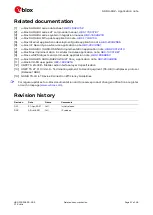
SARA-R42 - Application note
UBX-20050829 - R02
SMS
Page 46 of 58
C1-Public
12
SMS
12.1
Preferred message storage
The factory-programmed value for SARA-R4 series modules is "ME" for the three memory parameters
<mem1>, <mem2> and <mem3>. The setting can be set or read by the
+CPMS
AT command.
This is an example regarding the configuration of the
+CPMS
storage parameter for all memory
parameters to the same value.
Command
Response
Description
AT+CPMS="ME","ME","ME"
+CPMS: 0,23,0,23,0,23
OK
Set all three memory storage parameters
to “ME” memory storage.
AT+CPMS?
+CPMS: "ME",0,23,"ME",0,23,"ME",0,23
OK
Read the storage setting back.
For more details on the
+CPMS
AT command, see SARA-R4 series AT commands manual
12.2
SMS handling and access technology
All SARA-R4 MNO profiles use Combined Attach (CS & PS); if successful, both data and SMS services
are allowed. If LTE attach is successful for EPS only services, still SMS can be supported (the so called
“SMS only” case). If LTE
attach is not successful for SMS, the module can try registration on a
different RAT (e.g. 2G).
Accordingly the SMS support could be related to the selected access technology.
In particular, if
AT+URAT=8
is applied, the attach becomes
“
EPS only
”
(with "SMS only" additional
update type included). In this case, even if SMS services are accepted, the
+CREG
read command and
URC would report that it is not registered for CS services.
Since it can happen that SMS services are not supported in NB-IoT, in
AT+URAT=8
there is no means
to understand this other trying to send out an SMS. In addition, due to the fact that the network is
not including SMS only flag in the Attach accept, the module will repeat TAU every 10 s approximately,
with a consequent high power consumption. Summarizing:
1.
In mono-RAT (NB-IoT), i.e.
AT+URAT=8
, registered on a network without SMS support:
o
Tracking Area Update (TAU) procedures every 10 s for maximum 5 times every 12 minutes
(around 25 times per hour);
o
pay attention to power consumption;
2.
In multi-RAT (NB-IoT plus LTE Cat M1 and/or 2G), e.g.
AT+URAT=7,8,9
, registered on a network
without SMS support:
o
no TAU procedures every 10 s;
o
longer network scans (in any case the NB-IoT is the RAT with longest scans);
o
this configuration could be considered as a possible trade-off;
3.
In multi-RAT (NB-IoT plus LTE Cat M1 and/or 2G), e.g.
AT+URAT=7,8,9
registered on a network
with SMS support:
o
+CREG
indication is reliable in 2G RAT;
o
+CREG
indication is not reliable in LTE Cat M1/NB-IoT, accordingly try to send a SMS;
o
+CSCON
indication reports information about the radio connection status.
In conclusion the possibility to work in a multi-RAT configuration could be recommended and
considered as a possible workaround referring the scenarios described in the above points 1 and 2.













































